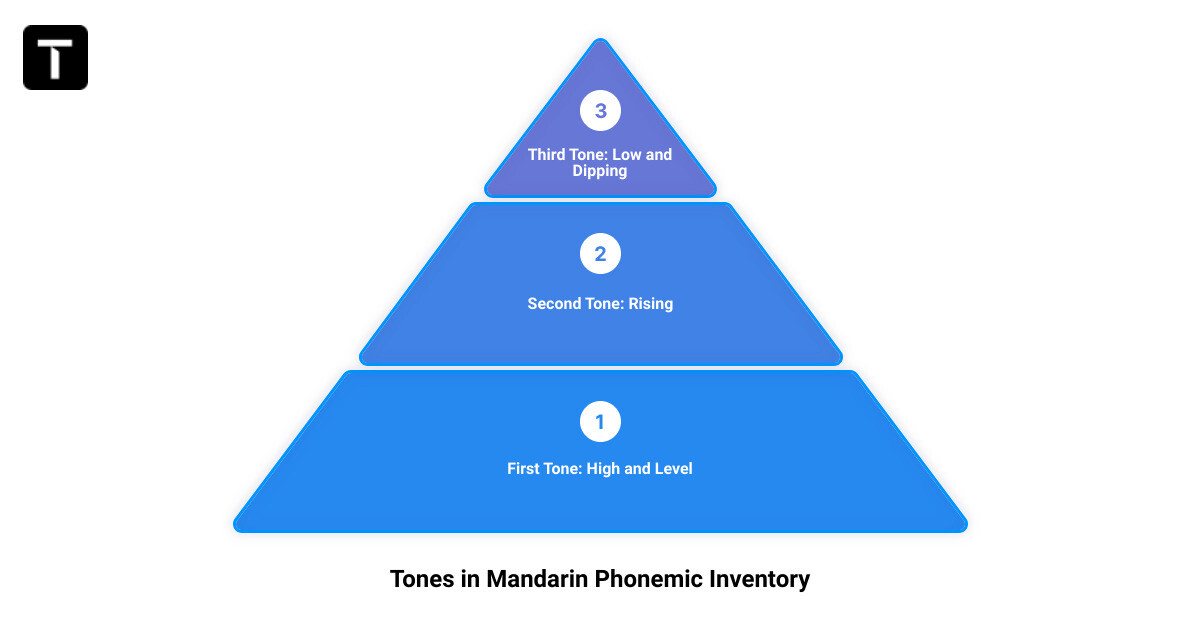Introduction to Mandarin Phonemic Inventory
Unlocking the intricacies of a new language can feel like solving a complex puzzle, and for the lifelong learner diving into Mandarin Chinese, the Mandarin Phonemic Inventory is a crucial piece of that puzzle. As you embark on your journey to master Mandarin, understanding this inventory - a detailed index of its unique phonemes or sounds - is key to grasping the language's pronunciation nuances and effectively communicating in it.
Mandarin Chinese is known for its rich phonetic landscape. From a whopping 22 consonant phonemes to the distinctive tonal system, the Mandarin Phonemic Inventory is a treasure trove of sounds that make this language unique and fascinating. Learning these phonemes - the smallest units of sound that can distinguish words in a language - becomes a cornerstone in your Mandarin learning journey.
In this article, we will unveil the secrets of the Mandarin Phonemic Inventory, from its fundamental building blocks to its application in the Pinyin system, a widely adopted phonetic spelling system for Mandarin Chinese. Also, we'll introduce you to the Traverse app, a science-backed Mandarin learning tool that leverages this inventory for effective learning.
So, let's dive in, explore the Mandarin Phonemic Inventory and take a step closer to sounding like a native Mandarin speaker.
Understanding Phonemes: The Building Blocks of Language
In the dynamic world of language learning, one particular concept stands as the fundamental building block: the phoneme. While it may seem like a complex term, understanding phonemes and their role in language can aid you in mastering Mandarin or any other language.
What is a Phoneme?
In its essence, a phoneme is the smallest unit of sound in a language that can distinguish one word from another. For instance, the sounds /p/ and /b/ are separate phonemes in English, as they differentiate the words "pat" and "bat".
Phonemes play a critical role in language learning, acting as the building blocks of words, and ultimately, communication. They're the sounds that make up the words we speak, the messages we convey, and the ideas we share.
Phonemic Inventory: A Closer Look
Delving deeper into phonemics, we encounter the term phonemic inventory. The phonemic inventory of a language is the set of distinctive phonemes, the unique sounds that distinguish one word from another. Each language has its own phonemic inventory, making it unique and distinct.
For example, English and Mandarin have different phonemic inventories. English distinguishes between the monophthong /oː/ and the diphthong /ou/, while Mandarin has 22 consonant phonemes without a contrast between voiceless and voiced stops and affricates such as between /p – b/ or /ts – dz/.
Understanding a language's phonemic inventory is crucial in the language learning process. It allows learners to distinguish between sounds, understand the structure of words, and ultimately, communicate effectively in the target language.
In the following sections, we'll explore the unique phonemic system of Mandarin Chinese, providing you with a deeper understanding of the language and paving your path to fluency. Whether you're a novice learner or someone looking to hone their Mandarin skills, understanding phonemes and phonemic inventory can prove to be the key to unlocking your language learning potential.
The Unique Phonemic System of Mandarin Chinese
Unraveling the complexity of Mandarin begins with understanding its phonemic system - a unique blend of consonants, vowels, and tones. This system forms the fundamental framework of Mandarin Chinese, guiding you in the production of accurate, comprehensible speech.
The Consonant Phonemes in Mandarin
Mandarin Chinese boasts a rich set of 22 consonant phonemes, some of which find parallels in the English language, while others are unique to Mandarin. For instance, while the consonants 'b' and 'p' in Pinyin are pronounced similarly to 'b' in 'book' and 'p' in 'spot' in English, the consonants 'zh', 'ch', and 'sh' have no exact English equivalents. These unique sounds often pose a challenge to new learners but mastering them is crucial for precise Mandarin pronunciation. Remember, Mandarin does not use a contrast between voiceless and voiced stops and affricates such as between /p – b/, or /ts – dz/.
The Vowel Phonemes in Mandarin
The vowel phonemes in Mandarin Chinese further enrich its phonemic inventory. Mandarin vowels often don't align with the English sounds we're accustomed to. For example, the pinyin "u" is pronounced more like the “oo” sound in the word “boot,” while the "e" sound in Chinese is similar to the sound in the word "people." By exploring and practicing these unique vowel sounds, you can significantly enhance your Mandarin pronunciation accuracy.

The Role of Tones in Mandarin Phonemic Inventory
The crown jewel of Mandarin phonemic inventory, however, is its tonal system. Mandarin Chinese is a tonal language, meaning the tone or pitch used when pronouncing a word can alter its meaning. There are four main tones in Mandarin, each with a distinctive pitch contour. For example, the syllable "ma" can mean mother, horse, hemp, or scold, depending on the tone used. Understanding and accurately pronouncing these tones is crucial, as a seemingly minor tone change can drastically change the meaning of a word.
The Mandarin phonemic system, with its unique blend of consonant and vowel phonemes along with its tonal nature, provides the language with its distinctive character. Mastering this system is a fundamental step in your Mandarin learning journey, allowing you to produce clear and accurate Mandarin speech. In the upcoming sections, we will delve deeper into how Mandarin's phonemic inventory compares with other languages and how the Pinyin system can aid in your Mandarin learning process.
Comparing Mandarin Phonemic Inventory with Other Languages
As we venture deeper into the world of Mandarin phonemic inventory, it's helpful to draw comparisons with other languages. This comparative analysis can provide useful insights into the unique characteristics of Mandarin and can assist in your learning journey.
Mandarin vs English: A Phonemic Comparison
The Mandarin phonemic system displays notable differences from English. English phonemic inventory is distinctive for its wide array of vowels and consonants, whereas Mandarin primarily relies on 22 consonant phonemes. Furthermore, English distinguishes between monophthongs and diphthongs, such as /oː/ and /ou/, which is a contrast not observed in Mandarin.
In terms of tones, English is a non-tonal language, whereas Mandarin utilizes four distinct tones that can alter the meaning of a word. This tonal aspect of Mandarin can initially pose a challenge for English speakers, as tonal variations are not a component of English phonology.
Mandarin vs Cantonese: A Phonemic Comparison
In comparing Mandarin with other Chinese languages, Cantonese presents an interesting case. Cantonese, like Mandarin, has a rich phonemic inventory but with a greater number of tones. While Mandarin has four tones, Cantonese boasts six or seven (depending on the dialect), making it a more complex tonal language. This tonal diversity in Cantonese can add another layer of complexity to your learning journey if you're transitioning from Mandarin to Cantonese or vice versa.
The Language with the Largest Phoneme Inventory: Taa
When we look beyond the realm of commonly spoken languages, we find intriguing languages like Taa (or ! Xóõ), a Khoisan language. This language holds the record for perhaps the largest number of phonemes of any language in the world. The phonemic inventory of Taa is remarkably rich, with vowels that can be pharyngealized, voiced, breathy, and epiglottalized.
While Mandarin's phonemic inventory is significantly less complex than Taa's, the comparison underscores the diversity of phonemic systems across the world's languages. As you continue your journey in mastering Mandarin, understanding these differences can provide a deeper appreciation for the unique nature of Mandarin's phonemic system. In the next section, we'll explore how the Pinyin system can further assist you in grasping Mandarin's phonemic inventory.
The Pinyin System: Phonetic Spelling for Mandarin Chinese
The world of the Mandarin language is filled with fascinating nuances, and one of them is the Pinyin system. Pinyin is a bridge between Mandarin Chinese and the Roman alphabet, serving as a critical tool in understanding and learning the Mandarin phonemic inventory.
The Importance of Pinyin in Learning Mandarin
The Pinyin system, translating to "spell sounds" in Mandarin, is a phonetic system designed in the 1950s to increase literacy rates and make the language more accessible to foreigners. This system offers a clear guide to Mandarin pronunciation, playing a pivotal role in Chinese literacy and learning.
Contrary to what its transcription into the Roman alphabet might suggest, Pinyin is not English. The pronunciation of Pinyin syllables does not always correspond to their English counterparts, meaning that getting the correct pronunciation for each Pinyin syllable is crucial. This is where the importance of Pinyin in learning Mandarin comes into play. It serves as your trusty guide, helping you understand and reproduce the unique sounds and tones of Mandarin.
How Pinyin Helps in Understanding Mandarin Phonemic Inventory
Mandarin Chinese is a tonal language, where different tones can change the meaning of a word. Pinyin provides a clear representation of Mandarin sounds, enabling you to navigate the world of Chinese tones effectively. It helps you pronounce new words and phrases accurately, even if you've never heard them spoken aloud before.
Moreover, Pinyin is also essential in learning to read and write Chinese characters. By knowing the Pinyin for a Chinese word, you can accurately pronounce and write the corresponding characters. For instance, by knowing the Pinyin for the Chinese word for China, Zhōngguó, you can accurately pronounce and write the characters 中國.
In essence, Pinyin is your key to unlocking the mystery of the Mandarin phonemic inventory, making your language learning journey more logical, enjoyable, and ultimately successful. As you dive deeper into the world of Mandarin phonemics, the Pinyin system will prove to be an invaluable tool, guiding you through the intricate maze of tones, sounds, and characters that make up this beautiful language.

Using Traverse App to Master Mandarin Phonemic Inventory
Unravel the secrets of Mandarin phonemic inventory with the Traverse app, a cutting-edge tool that takes Mandarin learning to a whole new level.
How Traverse App Facilitates Mandarin Learning
Traverse isn't just another language learning app. It's a cognitive science-powered platform that optimizes your learning process. With its unique features like mind mapping, spaced repetition flashcards, and connected note-taking, Traverse allows you to visualize the intricate links between Mandarin phonemes, facilitating the encoding, retention, and application of knowledge. It's not about rote memorization, but rather about internalizing the information to make it a part of you. This science-backed approach is what makes Traverse the best Chinese app to learn Chinese.
Importing Anki Decks for Continued Learning
Traverse takes personalization to the next level by allowing you to import your Anki decks. Anki, a popular flashcard app used by many language learners, is known for its effectiveness in memorizing vocabulary and characters. By importing your Anki decks into Traverse, you can continue to use your custom flashcards while leveraging Traverse's cognitive science-based learning methods. This integration makes your learning process even more efficient and tailored to your specific needs.
Partnership with Mandarin Blueprint for Effective Learning
To ensure a structured and comprehensive learning experience, Traverse has partnered with Mandarin Blueprint, an online Chinese course recognized for its engaging content. The Mandarin Blueprint method focuses on understanding the logic behind the language structure, making it easier for learners to grasp and remember new concepts. This strategic partnership enables users to learn Mandarin Chinese in a systematic and effective way, further enhancing the understanding of Mandarin phonemic inventory.
In essence, Traverse breaks down the complexities of the Mandarin phonemic inventory, making it accessible and manageable. It's the perfect tool for proactive learners who are committed to mastering Mandarin. With Traverse, you have a scientifically-backed, user-friendly platform that transforms your language learning journey into an engaging, rewarding experience.
Conclusion: The Journey to Mastering Mandarin Phonemic Inventory
Embarking on the journey to master the Mandarin phonemic inventory is an exciting and rewarding endeavor. This intricate system of consonants, vowels, and tones is a crucial part of the Mandarin Chinese language, and understanding it opens up a new world of communication and cultural understanding. While the concept of phonemes and their role in language might seem intimidating at first, it becomes more accessible with the right tools and resources.
Traverse, with its scientifically-backed approach, simplifies the process of mastering Mandarin phonemic inventory. It breaks down complex phonemes into manageable chunks, making learning more efficient and effective. The application of the Pinyin system further aids in understanding the pronunciation of these phonemes, bridging the gap between English and Mandarin.
The beauty of the Mandarin language lies in its unique phonemic inventory. From its 22 consonant phonemes and the intricate system of vowel phonemes to the distinctive use of tones, Mandarin Chinese stands apart in terms of its phonemic structure. The comparison with other languages like English and Cantonese, or even Taa - the language with the largest phoneme inventory, further underscores Mandarin's uniqueness.
Traverse's partnership with Mandarin Blueprint and its feature to import Anki Decks cater to the personalized needs of learners, providing a comprehensive and engaging learning experience. The Traverse App is not just a learning tool; it's a companion in your journey to mastering Mandarin, providing constant support and guidance.
In conclusion, mastering the Mandarin phonemic inventory is not just about learning a language; it's about embracing a new way of communicating, understanding a different culture, and broadening your horizons. It's a challenging task, but with resources like Traverse and a commitment to regular practice, success is within reach. So, gear up for an exciting journey to unlock the secrets of Mandarin Phonemic Inventory. The road might be long and winding, but the destination is worth every step.

